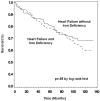Iron deficiency in community-dwelling US adults with self-reported heart failure in the National Health and Nutrition Examination Survey III: prevalence and associations with anemia and inflammation
- PMID: 21705484
- PMCID: PMC3180903
- DOI: 10.1161/CIRCHEARTFAILURE.111.960906
Iron deficiency in community-dwelling US adults with self-reported heart failure in the National Health and Nutrition Examination Survey III: prevalence and associations with anemia and inflammation
Abstract
Background: Iron deficiency has been proposed as a potential therapeutic target in heart failure, but its prevalence and association with anemia and clinical outcomes in community-dwelling adults with heart failure have not been well characterized.
Methods and results: Using data from the Third National Health and Nutrition Examination Survey, we evaluated the associations between iron deficiency, hemoglobin, C-reactive protein (CRP), and all-cause and cardiovascular mortality in 574 adults with self-reported heart failure. Iron deficiency was defined in both absolute and functional terms as a ferritin level <100 μg/L or between 100 and 299 μg/L if the transferrin saturation was <20%. Iron deficiency was present in 61.3% of participants and was associated with reduced mean hemoglobin (13.6 versus 14.2 g/dL, P=0.007) and increased mean CRP (0.95 versus 0.63 mg/dL, P=0.04). Over a median of 6.7 years of follow-up, there were 300 all-cause deaths, 193 of which were from cardiovascular causes. In age- and sex-adjusted Cox proportional hazards models, hemoglobin, CRP, and transferrin saturation but not iron deficiency were significantly associated with all-cause and cardiovascular mortality. In multivariate models, hemoglobin remained an independent predictor of cardiovascular mortality, whereas CRP remained an independent predictor of both all-cause and cardiovascular mortality.
Conclusions: Iron deficiency is common in heart failure and is associated with decreased hemoglobin and increased CRP. In multivariate analysis, hemoglobin was associated with cardiovascular mortality while CRP was associated with both all-cause and cardiovascular mortality. Iron deficiency was not associated with all-cause or cardiovascular mortality in this cohort.
Figures


References
-
- Jelani Q, Attanasio P, Katz SD, Anker SD. Treatment with iron of patients with heart failure with and without anemia. Heart Failure Clin. 2010;6:305–312. - PubMed
-
- Failla ML. Trace elements and host defense: recent advances and continuing challenges. J Nutr. 2003;133:1443S–1447S. - PubMed
-
- Gordeuk VR, Bacon BR, Brittenham GM. Iron overload: causes and consequences. Annu Rev Nutr. 1987;7:485–508. - PubMed
-
- Beard JL. Iron biology in immune function, muscle metabolism, and neuronal functioning. J Nutr. 2001;131:568S–580S. - PubMed
-
- Tang YD, Katz SD. Anemia in chronic heart failure: prevalence, etiology, clinical correlates, and treatment options. Circulation. 2006;113:2454–61. - PubMed
Publication types
MeSH terms
Substances
Grants and funding
LinkOut - more resources
Full Text Sources
Medical
Research Materials
Miscellaneous

